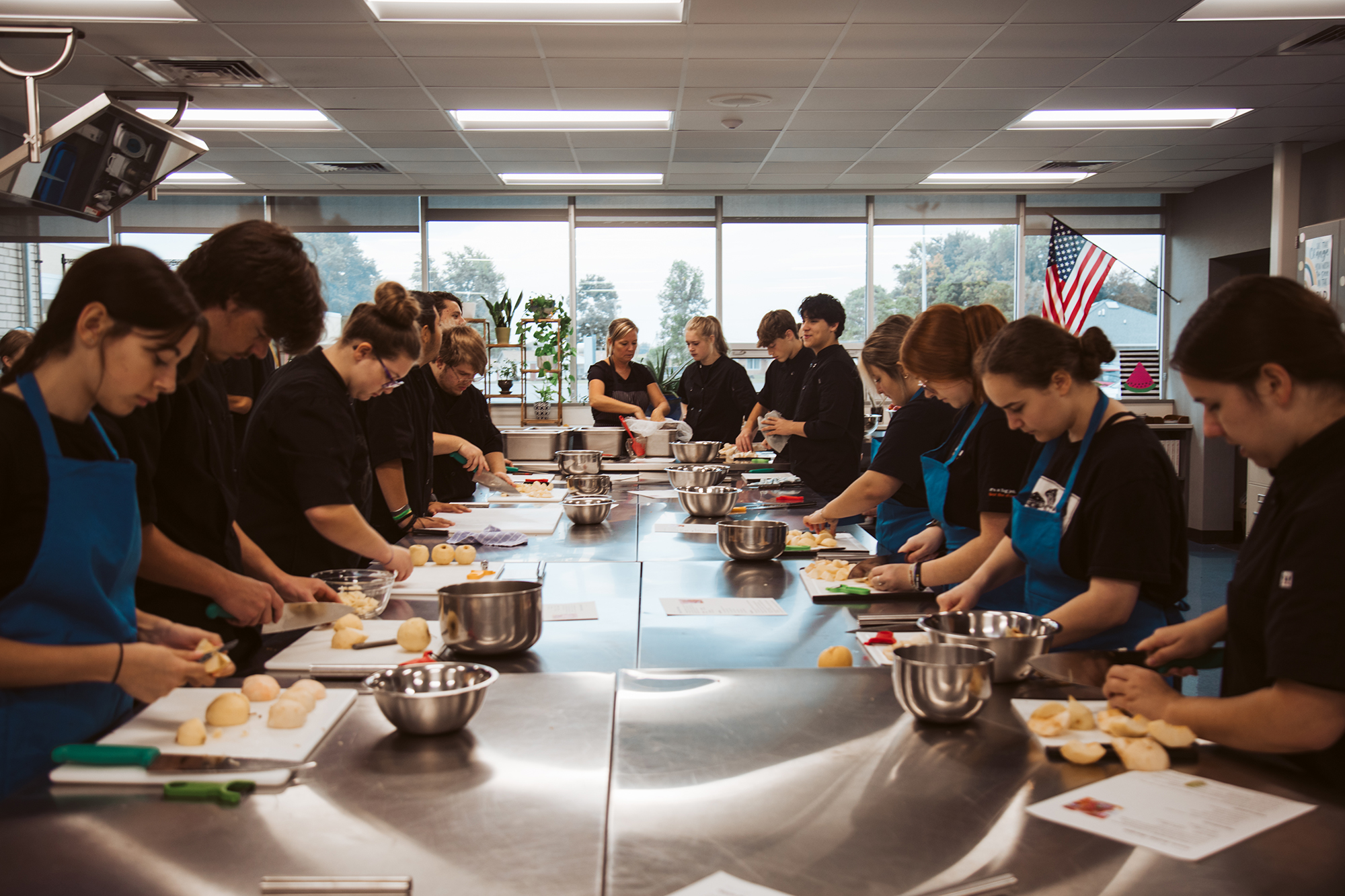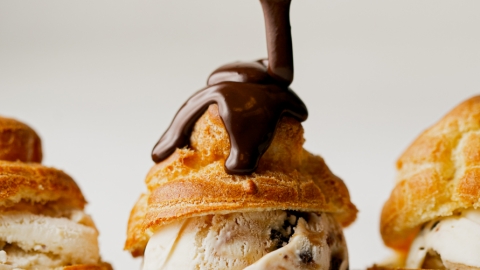Main Course
Hands-on classes introduce LaVille students to careers in culinary arts and hospitality.
It’s 10:30 in the morning and the hall smells like cheeseburgers. Which isn’t unusual at a high school, but we’re not that close to the cafeteria. Take another whiff and you, like many a passer-by between bells, will also catch the aroma of frying potatoes, onions and even bacon.
This is one of the culinary arts and hospitality classes at LaVille Junior-Senior High School in Lakeville, Indiana, taught by Jyll McNeil. Today is a test run for later in the week, when students will prepare sliders for a faculty and staff lunch with a tailgating theme.
Each group of two or three students got the same basic ingredients: ground beef, potatoes and other ingredients for the style of burger they chose based on their recipe research. They had one 2½-hour class for prep (one group baked some macaroni and cheese to stuff inside their burgers) and another 2-plus-hour class to cook, assemble, plate and present their creations to their classmates, making any adjustments necessary before doing it all again for the staff lunch.
This is just a small piece of the pie, so to speak, in the culinary arts/hospitality career path at LaVille, one that has come a long way since the days of melting a few slices of cheese in a pot, pouring it over macaroni and calling it a day. All public school students in Indiana must choose a career path when they are in the eighth grade. Culinary/hospitality is one. Others include agriculture, business and the arts, to name a few.
McNeil, who has taught for 21 years, the last two at LaVille, manages to incorporate all of those areas of focus into the culinary program, which also offers dual credit with Ivy Tech Community College and incorporates ServSafe food safety training into the curriculum. (You know what the first thing those 17 students did when it was time to cook on burger day? Wash their hands.)
Consider the Food Truck Competition, which tends to be a final project. Students create a business plan and a menu, with a cookbook full of recipes, and prepare one item off that menu. There is also an artistic angle: They design the look of their menu and even a model of the food truck itself. While they enjoy it, she says, they are surprised at how much work goes into it. Local chefs and food enthusiasts then come to class to judge the results.
“It really teaches them how much work and dedication goes into owning your own business, especially in this industry,” McNeil says.
For their hands-on culinary arts training, the students often begin with the basics. The extensive instruction in knife skills features several days of dicing, chopping, slicing and cutting potatoes, onions, fruits and vegetables (many of which are donated by local farms or other food providers), and demonstrating the different cuts, from small dice to chiffonade to julienne.
All that cut-up food ends up in the dishes the class prepares. There is lots of soup, but also applesauce, cider and apple butter when fall rolls around and a particularly large donation of apples comes in.
“I try to incorporate as much information about eliminating food waste as possible into my daily curriculum,” McNeil says. “We study food preservation within other units for the first several months of school. Freezer corn, corn stock, pesto, all kinds of things with tomatoes, pickles. … I really try to teach them about reinventing leftovers, using every part of the animal or plant and never throwing away food.”
The notion of wasting as little as possible was brought home during one of the many field trips—to restaurants, farms, bed and breakfasts, butcher shops, etc.—that the students take each year.
The class volunteered at Cultivate Food Rescue, a South Bend–based nonprofit that collects excess food from farms, grocery stores, colleges and schools, then repacks the food into meals for vulnerable members of the community. The time spent packing up all that food and understanding the challenges that can be associated with food is a real eye-opener for many of the students.
“It's so important to get the students out into the community and allow them to get a glimpse into all areas of the culinary and hospitality industry,” McNeil says. “I've had junior and senior high school students tell me that they haven't been on a field trip since elementary school. It's a great bonding experience for my class, which is so important because they have to work together as a team on a daily basis.
Field trips aside, actually getting into the kitchen together is a core principle of what the class teaches. “We do a lot of catering for the (school) corporation, which can lend itself to some stressful situations, and we have to be able to trust and rely on one another to get the job done,” McNeil says. “I always tell them that they don't have to be best friends but here they have to get along and work well together.”
That was important for Andrea Barragan, a former student of McNeil’s who is now a sophomore at Ball State University and majoring in hospitality and food management with a minor in travel and tourism.
“One of my favorite memories is when we all together as a class made tamales,” Barragan says. “I remember we made an assembly line that had perfect flow and we were all able to learn so much, and the outcome was amazing. Mrs. McNeil always showed a lot of interest in my culture, which made me feel safe and cared for. Overall, the class and her as a person (and) teacher have inspired and helped me to be where I am at in life right now.”
For her part, McNeil tells her students that even if they don’t travel the culinary path after school ends, what they learn will still be of use.
“Even if they don't want to do this as a career, it's the best hobby you can have,” she says. “I also stress the fact that you will most likely need to cook for yourself at some point and why not be comfortable with it. You will enjoy it more and make better food.”
Mike Petrucelli is a former food editor for the South Bend Tribune who now works in nonprofit communications. He and his wife live in Plymouth, Indiana.








